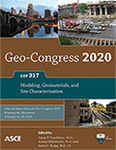Geo-Congress 2020
Probabilistic Field Assessment of Sinkhole Occurrence Using the Raveling Index
Publication: Geo-Congress 2020: Modeling, Geomaterials, and Site Characterization (GSP 317)
ABSTRACT
The electric cone penetrometer test (CPT) is becoming a popular subsurface investigation tool to understand a site’s soil stratigraphy and to estimate geotechnical design parameters. Moreover, CPTs are also a valuable tool to identify potential subsurface geohazards, such as potential liquefiable sand layers or subsurface karst anomalies indicative to sinkhole collapse. In this study, the authors review the current methodologies to detect and characterize subsurface karst soil anomalies and implement statistical regression procedures to set critical values of the sinkhole raveling index (RI). This was performed through analysis of 150 CPT soundings performed in Central Florida at sinkhole active sites. The RI value was calculated for each CPT, and the classification of CPT was categorized into severities of sinkhole formation based on its proximity to the reported sinkhole incident. Probability functions were then developed for the datasets, in turn relating RI data to the general probability of sinkhole manifestation at the ground surface. The results suggest that an RI value greater than 0.50 corresponds to an approximate range of 58–62% chance of sinkhole manifestation at the ground surface. Although this analysis technique does not incorporate the physical mechanism of internal erosion (i.e., raveling propagation over time), the developed analysis can still be used to better understand the potential of sinkhole formation within a project site when internally eroded soils are detected.
Get full access to this article
View all available purchase options and get full access to this chapter.
ACKNOWLEDGMENTS
The authors would like to express their gratitude to Kathy Gray of FDOT(ret.) for her insight on the development of the Raveling Index and sinkhole formation in central Florida, as well as to Dr. David Horhota and William Soehaili of FDOT for their assistance with the CPT data collection and FDOT public boring viewer database.
REFERENCES
Beck, B. F. (1984). "Sinkholes: Their Geology, Engineering, and Environmental Impact." First Multidisciplinary Conference on Sinkholes, Florida Sinkhole Research Institute, Orlando, FL.
Bloomberg, D., Upchurch, S. B., Hayden, M. L., and Williams, R. C. (1988). "Cone-penetrometer exploration of Sinkholes: Stratigraphy and soil properties." Environmental Geology and Water Sciences, 12(2), 99-105.
Boulanger, R. W., and Idriss, I. M. (2016). "CPT-Based Liquefaction Triggering Procedure." Journal of Geotechnical and Geoenvironmental Engineering, 142(2), 04015065.
Drumm, E. C., and Yang, M. Z. (2005). "Preliminary Screening of Residual Soil Stability in Karst Terrain." Environmental and Engineering Geoscience, 11(1), 29-42.
FDOT (2019). "Public Soil Boring Viewer Application." <https://gis.fdot.gov/Public_Soil_Boring_Viewer/<. (May 2019).
Iwasaki, T., Arakawa, T., and Tokida, K. (1984). "Simplified procedures for assessing soil liquefaction during earthquakes." International Journal of Soil Dynamics and Earthquake Engineering, 3(1), 49-58.
J. P. Bullock, and Dillman, A. (2003). "Sinkhole detection in Florida using GPR and CPT." 3rd International Conference on Applied Geophysics. Hotel Royal Plaza, Orlando, Fla.
Lee, D.-H., Ku, C.-S., and Yuan, H. (2004). "A study of the liquefaction risk potential at Yuanlin, Taiwan." Engineering Geology, 71(1), 97-117.
Perez, A., Nam, B., Alrowaimi, M., Chopra, M., Lee, S., and Youn, H. (2017). "Experimental Study on Sinkholes: Soil–Groundwater Behaviors Under Varied Hydrogeological Conditions." Journal of Testing and Evaluation, 45(1), 208-219.
Robertson, P. K., and Wride, C. E. (1998). "Evaluating cyclic liquefaction potential using the cone penetration test." Canadian Geotechnical Journal, 35(3), 442-459.
Shamet, Nam, and Horhota (2018). "Development of a Point-Based Index for Sinkhole Vulnerability Evaluation in Central Florida's Karst Terrain." IFCEE 2018 Orlando, FL, 212-221.
Shamet, Perez, and Nam (2017). "Sinkhole Risk Evaluation: Detection of Raveled Soils in Central Florida's Karst Geology Using CPT." Geo-Risk 2017 Denver, CO, 257-266.
Soliman, M., Perez, A., Nam, B., and Ye, M. "Physical and Numerical Analysis on the Mechanical Behavior of Cover-collapse Sinkholes in Central Florida." Proc., 15th Multidisciplinary Conference on Sinkholes and the Engineering and Environmental Impacts of Karst and the 3rd Appalachian Karst Symposium, National Cave and Karst Research Institute, 405-415.
Toprak, S., and Holzer, L. (2003). "Liquefaction Potential Index: Field Assessment." Journal of Geotechnical and Geoenvironmental Engineering, 129(4), 315-322.
Zisman, E. (2001). "A standard method for sinkhole detection in the Tampa, Florida, area." Environmental and Engineering Geoscience, 7, 31-50.
Zisman, E., and Clarey, D. (2013). "If It's Weight of Hammer Conditions, It Must be a Sinkhole?" Sinkholes and the Engineering and Enviornmental Impacts of Karst: Proc. of the 13th Mulidisciplinary Conference, Land, Doctor, and Stephenson, eds., National Cave and Karst Research Institute Carlsbad, NM, 45-52.
Information & Authors
Information
Published In
Geo-Congress 2020: Modeling, Geomaterials, and Site Characterization (GSP 317)
Pages: 602 - 611
Editors: James P. Hambleton, Ph.D., Northwestern University, Roman Makhnenko, Ph.D., University of Illinois at Urbana-Champaign, and Aaron S. Budge, Ph.D., Minnesota State University, Mankato
ISBN (Online): 978-0-7844-8280-3
Copyright
© 2020 American Society of Civil Engineers.
History
Published online: Feb 21, 2020
ASCE Technical Topics:
Authors
Metrics & Citations
Metrics
Citations
Download citation
If you have the appropriate software installed, you can download article citation data to the citation manager of your choice. Simply select your manager software from the list below and click Download.
